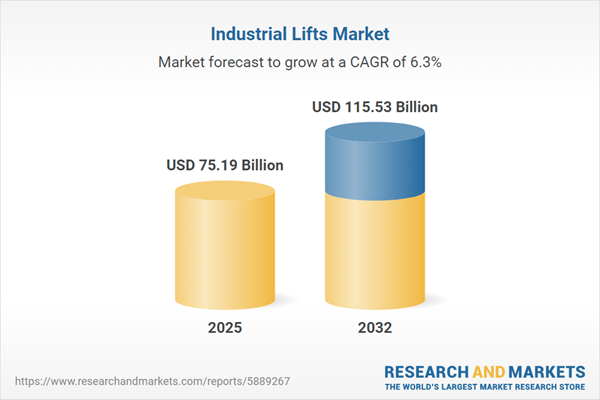Speak directly to the analyst to clarify any post sales queries you may have.
Industrial lifts have become central to advancing operational excellence across modern enterprises. As organizations prioritize workplace safety, efficiency, and compliance, decision-makers are integrating lift solutions that support reliable long-term performance in a rapidly changing industrial market.
Market Snapshot: Current Growth and Opportunities in the Industrial Lifts Market
The industrial lifts market holds a value of USD 70.75 billion and is expected to reach USD 75.19 billion in 2025, with a compound annual growth rate (CAGR) of 6.32%. Anticipated expansion to USD 115.53 billion by 2032 highlights strong momentum driven by automation uptake and shifting safety requirements. Sectors such as construction, manufacturing, warehousing, and logistics lead technological adoption, leveraging integrated lift technologies to improve compliance, protect employees, and adapt to regulatory dynamics and industry developments.
Scope & Segmentation of the Industrial Lifts Market
- Product Types: Boom lifts—articulated and telescopic—and scissor lifts address elevation and access challenges, while telehandlers and vertical mast lifts provide maneuverability and load precision for operations requiring secure movement of materials.
- Power Sources: Diesel-powered lifts are favored in intensive outdoor settings. Electric variants, preferred for indoor usage, minimize noise and emissions. Hybrid platforms deliver efficiency and operational flexibility to meet evolving compliance and project needs.
- Applications: Essential for construction, manufacturing, mining, oil and gas, and warehousing environments, industrial lifts accelerate workflows and support rapid response to dynamic operational demands.
- Height Ranges: Compact models are suitable for confined installations, mid-range options offer broad versatility, and specialized lifts ensure dependable access for complex tasks or non-standard spaces.
- Load Capacities: Light-duty lifts suit small-scale requirements and frequent repositioning, while heavy-duty platforms sustain demanding operations and robust throughput needs across industries.
- Regions Covered: The Americas, Europe, Middle East, Africa, and Asia-Pacific drive unique procurement and deployment patterns, shaped by distinct infrastructure, economic climate, and regulatory priorities in each market.
- Technologies Analyzed: Telematics enables real-time monitoring and smarter fleet management, while automation and modular electric systems support adaptable deployment as business requirements shift or regulations evolve.
- Key Companies Profiled: Profiles include KION Group AG, Toyota Industries Corporation, Jungheinrich AG, and Crown Equipment Corporation. Each company is assessed for innovation, digital integration, and how their strategies differentiate them within the market.
Key Takeaways for Senior Decision-Makers
- Adopting telematics and automation provides transparency for fleets and enhances readiness for predictive maintenance, helping achieve continuous asset performance.
- Strategic moves to electric and hybrid equipment assist in reaching sustainability goals and address growing regulatory pressures in global and regional markets.
- Embracing modular system designs and robust supply chain partnerships maximizes operational flexibility, preparing organizations for sudden supply or compliance changes.
- Digital interfaces and user-friendly controls streamline workforce onboarding, enabling organizations to quickly adapt and maintain productivity in volatile conditions.
- Expanded aftersales services and technical support structures ensure consistent operational capabilities, supporting deployment in multiple and varied geographic locations.
- Investing in targeted workforce training and diagnostic technologies delivers improved safety and performance standards, even within complex or high-risk environments.
Tariff Impact: Navigating Cost Structure and Supply Chain Shifts
Recent tariff changes in the United States are prompting organizations to reassess their procurement and supply chain strategies. Companies are responding by bringing production closer to key markets, diversifying suppliers, and optimizing inventories. These steps help maintain reliable equipment access, strengthen compliance practices, and increase operational resilience in the face of evolving trade regulations.
Methodology & Data Sources
This report leverages direct engagement with industry stakeholders, careful review of regulatory and company records, and analysis of recognized sector literature. Scenario modeling and a bottom-up approach underpin its value for strategic industrial lift market planning.
Why This Report Matters
- Offers a benchmark for digital adoption levels and supply chain preparedness, helping leaders assess their company’s standing against competitors and market standards.
- Provides actionable guidance for deploying capital, managing risk, and refining operational processes in an ever-shifting industrial landscape.
- Clarifies shifting regulatory trends, promoting informed compliance and more responsible decision-making across diverse applications and global regions.
Conclusion
This analysis offers senior leadership the insights necessary to guide strategic decisions, build operational resilience, and secure future success in the evolving industrial lifts market.
Additional Product Information:
- Purchase of this report includes 1 year online access with quarterly updates.
- This report can be updated on request. Please contact our Customer Experience team using the Ask a Question widget on our website.
Table of Contents
3. Executive Summary
4. Market Overview
7. Cumulative Impact of Artificial Intelligence 2025
Companies Mentioned
The companies profiled in this Industrial Lifts market report include:- KION Group AG
- Toyota Industries Corporation
- Jungheinrich AG
- Crown Equipment Corporation
- Hyster-Yale Materials Handling, Inc.
- Mitsubishi Logisnext Co., Ltd.
- Komatsu Ltd.
- Doosan Industrial Vehicle Co., Ltd.
- Hangcha Group Co., Ltd.
- Godrej & Boyce Manufacturing Company Limited
Table Information
| Report Attribute | Details |
|---|---|
| No. of Pages | 194 |
| Published | October 2025 |
| Forecast Period | 2025 - 2032 |
| Estimated Market Value ( USD | $ 75.19 Billion |
| Forecasted Market Value ( USD | $ 115.53 Billion |
| Compound Annual Growth Rate | 6.3% |
| Regions Covered | Global |
| No. of Companies Mentioned | 11 |









